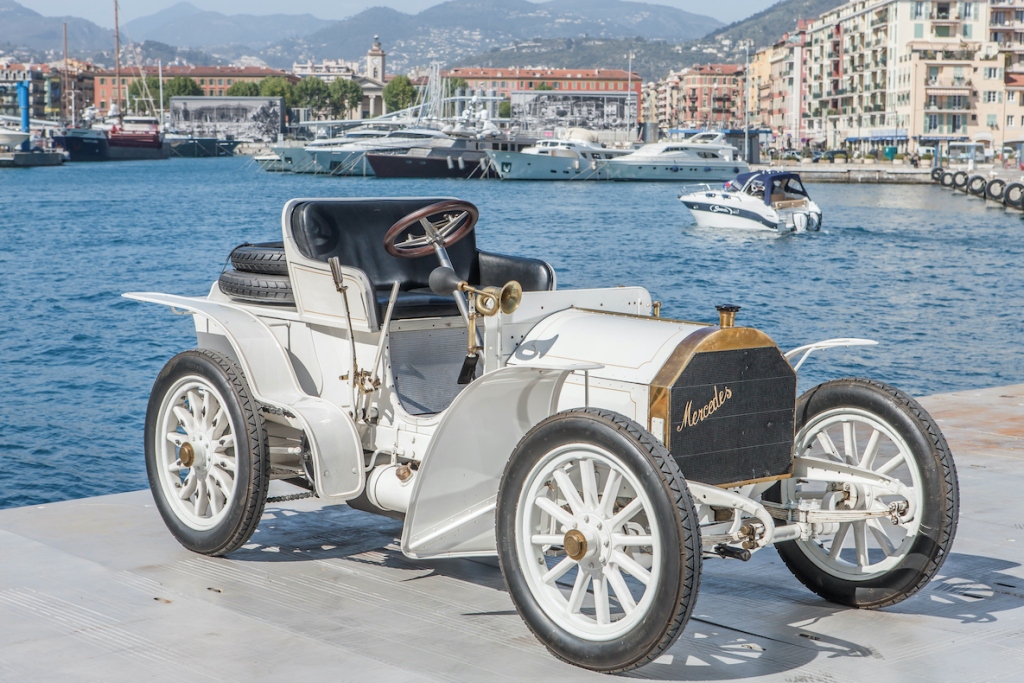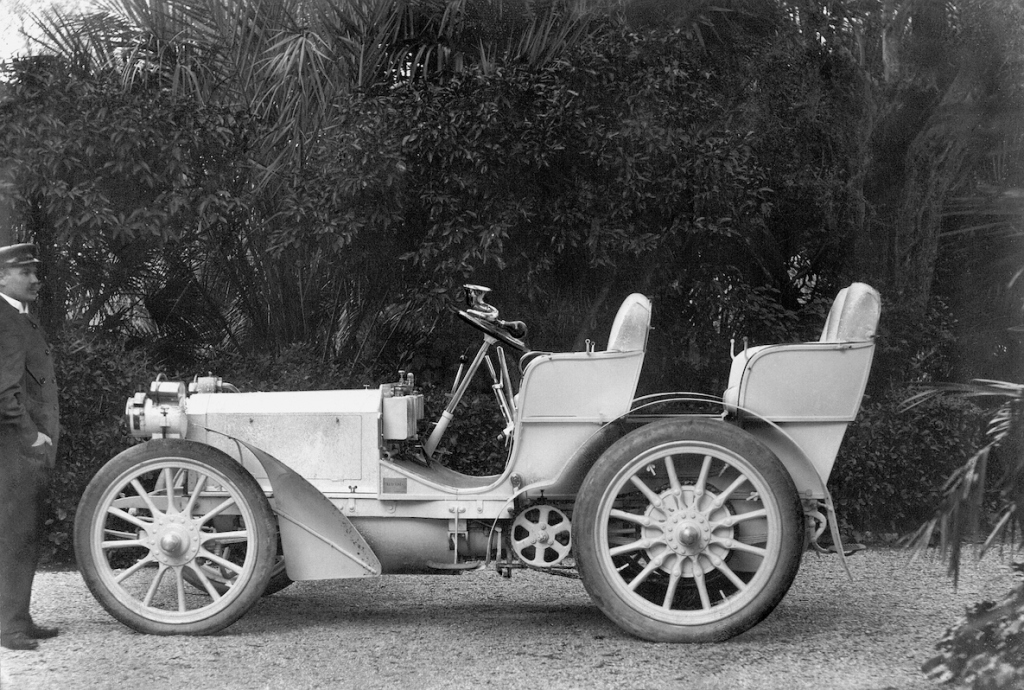Over 120 Years: Mercedes Is Unbeatable
“Mercedes” is one of the most famous and most traditional: from 1900 onwards, it was used to brand the innovative passenger cars made by Daimler-Motoren-Gesellschaft, and, together with its outstanding vehicle and engine technology, it gave the company worldwide recognition and thus shaped personal mobility as a whole. In 1926, the brand was extended to produce Mercedes-Benz – while its significance on all continents remained unchanged. For the oldest luxury car brand in the world, its name is both the basis and incentive to carry this outstanding tradition into the future.
Businessman and motorcar enthusiast Emil Jellinek was well aware of the importance of a brand name that was easy to remember. At the beginning of April 1900, he concluded an agreement with Daimler-Motoren-Gesellschaft (DMG) in Nice on the distribution of Daimler cars and engines. The decision to develop a new engine, which was to bear the name Daimler-Mercedes, was a further ground-breaking step: it meant that the name that Jellinek had been using as a pseudonym for several years became the product name. On 22 December 1900, DMG delivered the first car equipped with the new engine to Nice, a 35 P.S. racing car.
The vehicle was not only the newest and most powerful model produced by DMG – it has since come to be recognised as the very first modern motorcar. The Mercedes 35 P.S. was systematically designed for performance, weight savings and safety, its key features including a lightweight, high-performance engine, a long wheelbase and a low centre of gravity. With these attributes and the honeycomb radiator organically integrated into the front, it gave the motorcar its distinct form: the first Mercedes was no longer reminiscent of a carriage pulled along by a combustion engine instead of horses. Rather, it was a new construction which had been systematically designed from scratch for the innovative new type of drive. Experts were immediately aware that this vehicle marked a profound change in the field of automotive engineering. Paul Meyan, the founding member and secretary-general of the motorcar Club de France (A.C.F.), is on record as having commented: “We have entered the Mercédès era.”
Mercedes Is Unbeatable
During Nice Week (“Semaine de Nice”) in March 1901, at that time arguably the most important international motorsport event, the Mercedes cars entered were unbeatable in practically every discipline. This helped Jellinek and Mercedes to achieve exceptional publicity. “French designers have nothing comparable to offer at present,” wrote the “La Presse” newspaper on 30 March 1901. In March and August 1901, the sister models, the 12/16 PS and 8/11 PS, were launched. Jellinek’s business was booming: in society’s most exclusive circles, it was the done thing to drive a Mercedes or, even better, to be driven in one. The Daimler plant in Cannstatt was hardly able to keep up with the production demand.

The Brand Name and the Young Girl
The brand name goes back to Jellinek’s daughter, Mercédès, who grew up in a family that was obsessed with motorcar technology: Emil Jellinek, who lived in Baden near Vienna and Nice, insisted on more significant performance and more innovative technology from Daimler-Motoren-Gesellschaft in the closing years of the 19th century, which resulted in the development of the modern motorcar. From 1899 on, he competed in car races on the Côte d’Azur in high-performance Daimler cars under the pseudonym “Monsieur Mercedes”, the first name of his daughter, who was born in 1889.
Following the ground-breaking motorsport and market successes of Mercedes cars, the name “Mercédès” was applied for as a trademark on 23 June 1902 and legally registered on 26 September. Emil Jellinek took this a step further one year later, and in June 1903 he received permission to change his name to Jellinek-Mercedes from then on. He commented on the decision thus: “This must in all probability be the first time that a father has borne the name of his daughter.”
Easy Operability: The Simplex Model Family
Even in France, where the motorcar enjoyed unusually early success, cars remained conspicuous by their absence in everyday life at the turn of the 20th century. The registration statistics for France nevertheless show 4,427 luxury passenger cars in 1901, plus 959 motorcars for commercial use. However, the product was continuously being developed and was becoming more widespread.
The first Mercedes and its less powerful sister models designed according to the same principles gave rise in 1902 to the Mercedes-Simplex model family, which initially comprised three models. The “Simplex” designation alluded to the vehicles’ ease of operation by the standards of the day. The most powerful variant in 1902 was the Mercedes-Simplex 40 PS, the direct successor to the Mercedes 35 P.S. The Mercedes-Simplex vehicles were equally successful as innovative racing cars and as sporty everyday luxury motorcars.

Nice-La Turbie Race
They also triumphed at Nice Week: in 1902 the Mercedes-Simplex 40 P.S. won the Nice-La Turbie race, followed in 1903 by the 60 P.S. model which set a new record time. A particularly memorable feat was the victory by Camille Jenatzy in a Mercedes-Simplex 60 P.S. in the 1903 Gordon Bennett race, which was the leading international motorsport event of the day. The original plan was to field the markedly more powerful 90 hp racing cars, but these were destroyed in a fire at the DMG factory in Cannstatt three weeks before the race. DMG thus raced the privately-owned near-series Mercedes-Simplex 60 P.S. The vehicle belonging to American millionaire Clarence Gray Dinsmore won the race with Jenatzy behind the wheel.
The final models bearing the Mercedes-Simplex designation appeared in 1904. These included the 28/32 PS model, a more advanced variant of the 28 P.S. model from 1902. The “Simplex” designation disappeared from the model names of the Mercedes motorcars in 1905. but the unique, global success story of the series production vehicles and racing cars which began with the Mercedes 35 P.S. in 1901 continues to this day.
A New Star on the Horizon
The Mercedes star? The star was registered as a trademark by DMG in June 1909 both as a three-pointed and a four-pointed star. Both versions were protected by law, but only the three-pointed star was actually used and, from 1910 on, it was seen embellishing the radiators of Mercedes vehicles in a three-dimensional form. The three tips of the star were also regarded as a symbol of Gottlieb Daimler’s efforts to achieve universal motorisation “on land, at sea and in the air” – a vision he consistently pursued from the very beginning.
When Daimler-Motoren-Gesellschaft and Benz & Cie. merged in 1926, a new brand name was created, which incorporated the key elements of the emblems used up to that time: the three-pointed star of Daimler-Motoren-Gesellschaft surrounded by the word mark “Mercedes” and the equally prestigious brand name “Benz”, whose laurel wreath connected the two words. This trademark still adorns the vehicles of the Mercedes-Benz brand today and is regarded throughout the world as the epitome of tradition and innovation, and the future of the motorcar.
The Vision Mercedes Simplex, 2019
One example of this is the “Vision Mercedes Simplex”, which Mercedes-Benz Design presented in September 2019. It is a sculpture that symbolises both the origin and the future of the Mercedes-Benz luxury brand. It symbolises the transition to a new era of design and technology. At the same time, it is a homage to the historical legacy and the birth of the brand.
The “Vision Mercedes Simplex” carries the pioneering spirit and design characteristics of that time far into the 21st century. Its message? The passion for luxury and innovation is part of the Mercedes-Benz brand D.N.A. This brand D.N.A. gives Mercedes-Benz the strength to set new standards in mobility over again, yesterday, today and tomorrow. At the same time, the sculpture shows that Mercedes-Benz is continuing to drive forward the transformation of the car and mobility as a pioneer.

“Only a brand that is as strong as Mercedes-Benz is capable of the physical symbiosis of history and future. The ‘Vision Mercedes Simplex’ symbolises the transformation of the brand-specific luxury of Mercedes-Benz”, says Chief Design Officer Gorden Wagener.
At a stroke, these successes established Daimler-Motoren-Gesellschaft as the leading manufacturer of sporty and luxurious motorcars. Jellinek proved adept at translating the given potential into successful sales. During Nice Week of 1901 he had Werner parade the winning vehicle in front of the assembled spectators, now fitted out as a four-seater vehicle with an additional rear bench. This had the desired effect of numerous orders for the businessman. Other racing triumphs, such as in the Semmering race in September 1901, further underscored the Mercedes vehicle’s potential. Thus began Daimler-Motoren-Gesellschaft’s success story as a business enterprise, too.
NEXT UP IN NEWS
- Al Ghandi Auto Launches Its Stay at Home Courtesy Service to Curb Social Interaction and Limit the Spread of COVID-19
- Volkswagen Presents New Models in Digital Mode for the First Time
- Automotive Report 2020 – Deeper Data Analysis in a New Aesthetic Appearance
- Jaguar Land Rover Starts Production of NHS-Approved Protective Visors
- Jaguar and Land Rover Deploy Global Fleet of Vehicles to Aid COVID-19 Crisis
- Automobili Lamborghini Produces Surgical Masks and Medical Shields for Sant’Orsola-Malpighi Hospital in Bologna


Comments are closed.